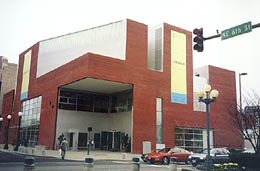The Bellevue Art Museum originated in 1947 as a street-based art fair, and then moved indoors, first to a surplus schoolhouse, then to a former funeral home, later to the somewhat isolated third floor of the Bellevue Square shopping center. On January 13, 2001, it officially opened its first purpose-built home, a bold red-stained concrete structure located at NE 6th Street and Bellevue Way in the heart of the city's downtown. It is the first major avant-garde building on the Eastside, intended, according to architect Steven Holl (b. 1947), as "a prototype for urbanizing a sprawling suburban zone" through its compactness, underground parking, and lot-filling form. The building served for two-and-a-half years before the Bellevue Art Museum closed its doors due to lack of funds. After hiring as director veteran curator of crafts and design Michael Monroe, and raising $3 million, the museum reopened on June 18, 2005, with a new focus on crafts and a new name -- Bellevue Arts Museum.
A Major Avant-garde Building
The Bellevue Art Museum is the first major avant-garde building on the Eastside, and according to Holl is intended as "a prototype for urbanizing a sprawling suburban zone" through its compactness, underground parking, and lot-filling form. Such high ambition cannot realistically be achieved through one 36,000 square foot building, but the museum provides some missing ingredients to this prosperous suburban downtown -- a structure of arresting visual character, a small sidewalk cafe, and a lively center of non-commercial public activity.
The Bellevue Art Museum is not a conventional art museum; it has no permanent collection and emphasizes education and hands-on involvement through a busy schedule of art classes and workshops. The building is thus part school, part studio, and part gallery. These functions, along with a small auditorium, library, museum store, cafe, and administrative offices, are grouped around a central two-story atrium, or Forum, which also houses a grand staircase.
Many of the internal spaces are unconventionally and evocatively shaped, particularly the main exhibition galleries, which may prove less than ideally workable for their function due to their elongation and the need to block excessive daylight, which is harmful to many artworks. (Two galleries were altered even before construction was complete.) Six outdoor roof terraces of varied sizes and shapes will also be used as art spaces, largely though image projection.
The building makes its architectural statements more through bold gestures than refinement. Although it was well-budgeted at $417 per square foot, its materials, finishes, and details are not always consistent in quality and execution. Perhaps acknowledging this characteristic, Holl calls the Bellevue Art Museum "an art barn."
Illuminations
As is often the case in the architect's works, daylight is an important element of the design, introduced though flat disk skylights, channel-glass clerestories, and large window expanses. Indirect artificial lighting is also imaginatively used to create a sense of natural illumination, a welcome touch in a climate that tends to grayness.
At night, the building glows from within and displays projected images on aluminum panels flanking its terraces, and on the ceiling of its spacious entrance porch.
Although it was small in its context of sprawling retail complexes and high-rise offices and hotels, the Bellevue Art Museum was a major symbolic step in the city's evolution.
However, on September 30, 2003, the museum closed its doors, due to lack of funds. The opening of the new building coincided with the dot-com bust, among other possible reasons for the museum's financial difficulties. In early October 2003, the museum Board of Directors chose Mark Haley, Tacoma heir of Brown & Haley, a candy-manufacturing firm, as interim managing director. Haley, a longtime booster of the arts, worked to devise a viable business plan that would meet with the approval of community leaders, potential donors, and museumgoers.
In August 2004, the museum board chose Michael Monroe to be the executive director and chief curator. Known as a "long-term force in craft circles" (Farr), Monroe served as curator at the Smithsonian Institution's Renwick Gallery for American Craft from 1974 to 1995, among other accomplishments. He immediately joined in the fundraising effort, putting energy and his extensive contacts to work in the cause of the museum.
Under his leadership, after a successful $3 million fundraising campaign, the museum opened as the Bellevue Arts Museum on June 18, 2005. The reopened museum features a new name, a new mission focused on crafts and design, and a redesigned space with new galleries.

